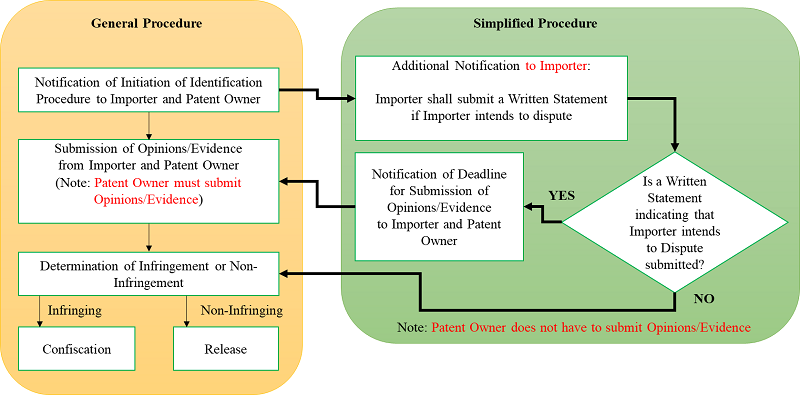ブログ
Patents and Designs have been added to the scope of simplified Identification Procedures at Customs, reducing the labor and economic burden on patent owners and design owners
2023.11.30
Introduction
Japan Customs suspends the import of products that infringe intellectual property (IP) rights. When Customs finds suspicious products that may infringe IP rights, Customs initiates an Identification Procedure. As a result of the Identification Procedure, if Customs determines that the products infringe Japanese IP rights, Customs may confiscate the products. In the Identification Procedure, the simplified procedure was limited to trademark and copyright cases, etc., but has been expanded to include patent and design cases, etc., as of October 1, 2023. In this article, focusing on patents, we introduce the simplified procedure and other interesting topics.
Statistics
As shown in the table below, the number of import seizures increased drastically in 2019 and has been gradually increasing since then. This tendency suggests that patent owners consider Customs as one of the most useful forums to halt the import of products that infringe upon patents.
[Number of Import Seizures based on Patents]
|
Year |
2017 |
2018 |
2019 |
2020 |
2021 |
2022 |
2023 |
|
Cases |
18 |
6 |
83 |
116 |
174 |
280 |
113 |
Source: https://www.mof.go.jp/policy/customs_tariff/trade/safe_society/chiteki/
Overview of Procedures
If patent owners believe that products, which are deemed to infringe a patent right in Japan, are about to be imported, patent owners can request Customs to suspend the import of the products and to take Identification Procedures.
Application Procedure
A patent owner submits a suspension application to Customs, which must include the following:
ⅰ. Statement that the patent owner owns the patent;
ⅱ. Statement that the patent is valid;
ⅲ. Statement that the patent has been infringed or is likely to be infringed;
ⅳ. Prima facie evidence of infringement of the patent; and
ⅴ. Information that enables Customs to identify products subject to the application.
No official fees are incurred for this submission.
The submitted application is supposed to be published on the Customs websites to give interested parties an opportunity to file arguments against the application. If interested parties file opinions and Customs finds it difficult to make a decision regarding whether to approve the application, Customs may seek opinions from a panel of three (3) expert advisors (lawyers, patent attorneys, and scholars). If Customs approves the application, the application will be valid for four (4) years at the most and may be renewable.
Identification Procedure
The Identification Procedure is triggered once Customs detects suspicious products. In the Identification Procedure, Customs decides whether suspicious products infringe upon a patent.
(1) General Procedure
Customs notifies both importers and patent owners of the initiation of the Identification Procedure. The importers and the patent owners can submit their opinions and evidence to Customs within ten (10) business days. The importers may argue non-infringement and/or the invalidity of the patent. The opinions and evidence submitted by both parties may be exchanged to give both parties an additional opportunity to submit a counterargument. Customs then makes a decision whether the suspicious products infringe upon the patent. The decision is generally made within one (1) month.
As with the Application Procedure, Customs may also seek opinions from a panel of three (3) expert advisors, if Customs finds it difficult to determine whether the suspicious products infringe upon the patent. In typical cases, however, expert opinions are rarely sought.
If Customs determines that there is no patent infringement, the import of the products is granted. In contrast, if Customs determines that there is a patent infringement based on opinions/evidence submitted by patent owners, Customs may confiscate the infringing products, provided that no measures of voluntary disposal have been taken during the period for protest.

(2) Simplified Procedure
In the simplified procedure, Customs can proceed to make a decision whether the suspicious products infringe upon the patent without asking patent owners to submit opinions and evidence, if importers do not submit any written objections to Customs within the designated period.
Specifically, as shown in the chart above, in the Notification of Initiation of Identification Procedure, importers are additionally notified to submit a Written Statement within ten (10) business days if the importers intend to dispute whether or not the products fall under infringing products.
If there is no submission of a Written Statement, Customs proceeds to make a decision whether the suspicious products infringe upon the patent. Therefore, there is no need for patent owners to submit opinions and evidence. Given that Customs finds the products to be possible of patent infringement when initiating Identification Procedures, it is expected that Customs is highly likely to decide that the products infringe upon the patent.
In contrast, if there is a submission of a Written Statement, Customs notifies both the importers and patent owners of the deadline to submit opinions and evidence to Customs. Subsequent procedures are the same as the general procedures.
Comments
The owners of patent rights and design rights have become able to enjoy the benefits of the simplified identification procedures for imports of products before Customs. Thanks to the simplified identification procedures, patent owners and design owners are expected to utilize Customs as a useful means to enforce their rights while they benefit from a reduced labor and economic burden. Given that Customs procedures are simple, speedy, and cost-effective, not only patent right owners but also other IP right holders should consider Customs as a forum to seek an injunction on infringing products in addition to district courts.
Member
PROFILE

